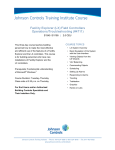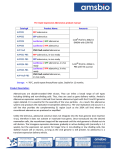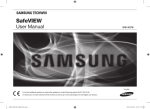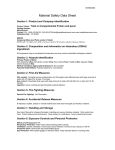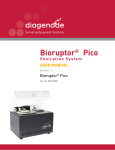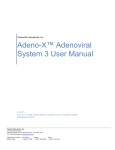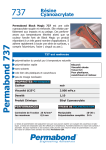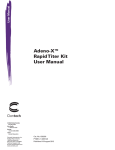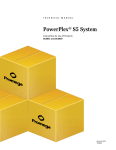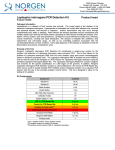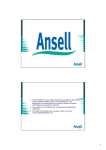Download Adeno-1 Expression System
Transcript
Adeno-1 Expression System Enables efficient construction of recombinant adenoviruses. Store kit at !20ºC Store Ad!competent cell at !70ºC User Manual Version 2, January 2007 www.capitalbiosciences.com 1. Introduction Application: The Adeno!1 Expression System provides an efficient method for constructing recombinant adenoviruses. Our procedure uses in vitro ligation to subclone your gene of interest into a replication! incompetent (!E1/!E3) human adenoviral type 5 (Ad5) genome. This approach enables you to produce recombinant adenoviruses quickly (less than 3 weeks) and reliably. Our pShuttle vectors (+/!) have very flexible cloning sites, which allow easy subcloning manipulation. 2. Kit Contents Table 1. Kit Contents. Component Quantity Kit Verizon v1.2 v1.1 ! ! ! ! v1.3 ! v1.4 v1.5 !! !!! !! ! Adeno DNA 5ug pShuttle vector (+) 5ug pShuttle vector (!) 5ug ! ! ! 5ug ! ! ! 2x50ul ! !! 2x100ul ! !! ! ! ! ! !! ! ! !! ! ! !! pShuttle!Laz control vector Enzyme pack: PI!Sce I and I!CeuI; including buffer Recombinant adenovirus PCR screening set 293 cells 1x10e6 ! Ad!competent cells 10x50ul ! Glycogen 20mg/ml 100ul ! - Store Ad!competent cells at !70ºC and all other components at !20ºC. Spin briefly to recover contents Avoid repeated freeze!thaw cycles 2 v1.6 ! ! ! ! 3. Experimental Procedure 3.1 Cloning your gene of interest into the pShuttle (+/-): 3.1.1 Subclone your gene of interest into the pShuttle(+/!) using any of the unique restriction sites located in the MCS region. 3 3.1.2 PI!Sce I/I!Ceu I digestion of recombinant pshuttle and adeno DNA a. Prepare a 30"l PI!Sce I/I!Ceu I double!digest of your pShuttle and adeno DNA. b. Combine the reagents shown in Table 2 in a sterile 1.5 ml microcentrifuge tube. c. Mix well and spin briefly to collect liquid. d. Incubate at 37ºC for exactly 3 hours. e. Perform phenol:chloroform:isoamyl alcohol (25:24:1) extraction by using the protocol in Appendix A. Table 2. PI!Sce I/I!Ceu I Double!Digest of pShuttle and pAdeno DNA Reagent Volume pShuttle Plasmid or pAdeno DNA 2!3ug 10X Double Digestion Buffer 3ul PI!Sce I Restriction Enzyme (1 unit/ul) 2ul I!Ceu I Restriction Enzyme (1 unit/ul) 2ul 10X BSA 3ul Sterile H2O x ul Total Volume 30ul 4 3.2 Produce recombinant adenoviral DNA: 3.2.1 Subclone your expression cassette into the Adeno genome: a. Combine the reagents shown in Table 3 in a sterile 1.5 ml microcentrifuge tube in the order as shown. b. Gently mix, then spin briefly in the microcentrifuge. c. Incubate at room temperature for 1!2 hours. d. To the ligation product, add the following: ! 1.5 "l 10X Swa I digestion Buffer ! 1.5 "l 10X BSA ! 1.0 "l Swa I enzyme ! 1.0 "l ddH2O e. Incubate at room temperature for 1!2 hours. f. Perform phenol:chloroform:isoamyl alcohol (25:24:1) extraction by using the protocol in Appendix A. Table 3. Ligation of pShuttle to Adenovector Reagent Volume PI!Sce I/I!Ceu I digested vector 4ul PI!Sce I/I!Ceu I digested pShuttle 3ul 5X DNA Ligation Buffer 2ul DNA Ligase 1ul Total Volume 10ul 3.2.2 Transform E.coli with ligation products a. Transform electro! or chemically competent DH5# or our Ad! competent (Cat . VSA-0002) cells with the Swa I digestion product. b. Select for ampicillin!resistant (Ampr) transformants by plating the transformation mixture on a LB agar/Amp plate (100 "g/ml ampicillin). Incubate overnight at 37ºC. c. Pick up 10 colonies and inoculate into 100 "l LB/Amp medium in a sterile Eppendorf tube in the early morning. d. After 5!6 hours of incubation, screen for positive clones using PCR with Adeno screening primer mix (using the protocol in Appendix B). e. When you have identified a bacterial clone carrying the desired recombinant, inoculate 100!500 ml of LB/Amp 5 medium with all the bacteria (100 "l) from the 1.5 ml Eppendorf tube. f. Incubate the culture at 37ºC overnight. g. Purify the plasmid using our Column Pure Plasmid Maxi!Prep Kit (Cat No D205) or the Qiagen kits. Expected yield: 30!50 "g plasmid DNA/100 ml culture. Note: pAdeno is a large plasmid (>30 kb) that is susceptible to damage and rearrangement in E.coli. For best results, always use fresh, log!phase cultures for purification of recombinant pAdeno DNA. Do not store your culture at room temperature, 4ºC, or on ice for long periods ( i.e. >24 hours) before starting purification. 3.2.3 Analyze putative recombinant Adenoviral DNA by PCR or restriction digestion PI!Sce I and I!Ceu I Restriction Analysis: a. Set up 30"l PI!Sce I/I!Ceu I double digests by combining the reagents in Table 4 in a sterile 1.5 ml microcentrifuge tube. b. Mix well and spin briefly to collect contents. c. Incubate at 37ºC for exactly 3 hours. d. Verify the insert by electrophoresis on a 0.8!1% agarose/SafeView (Cat.No DG108) gel. Important: Since I!Ceu I and PI!Sce I tend to remain bound to DNA, use a gel loading buffer that contains SDS (final concentration after combining with sample: 0.1%), heat to 65oC for 10 minutes before loading. Table 4. Restriction Analysis of Recombinant Adenoviral DNA Reagent Volume Adenoviral DNA 3ug 10X Digestion Buffer 3ul 10X BSA 3ul PI!Sce I (1 unit/ul) 2ul I!Ceu I (1 unit/ul) 2ul ddH2O x ul Total Volume 30ul 6 PCR Analysis: You can also screen pAdeno DNA for the presence of pShuttle derived expression cassettes by using PCR with Adeno forward and reverse PCR primers (using the protocol in Appendix B). These primers specifically amplify a 350!bp sequence that spans the cloning site in pAdeno. Only recombinant pAdenoviral templates are amplified since non!recombinants lack the pShuttle sequence needed for annealing with the reverse primer. 3.2.4 Preparing Recombinant Adenoviral DNA for Transfection a. In a sterile 1.5 ml microcentrifuge tube, combine the reagents in Table 5. b. Mix contents and spin the tube briefly. c. Incubate at 37ºC for 2 hours d. Perform phenol extractions by using the protocol in Appendix A. Table 5. Pac I Digestion of Recombinant Adenoviral DNA Reagent Volume Recombinant Adenoviral DNA 3ug 10X Pac I Digestion Buffer 4ul 10X BSA 4ul Pac I (10 units/ul) 2ul ddH2O x ul Total Volume 40ul 3.3 Generate the recombinant adenovirus in packaging cells: 1. Plate 293 cells at 70% confluency in a 6!well plate 12!24 hrs before transfection. 2. Incubate the plate(s) at 37ºC in a humidified atmosphere maintained at 5% CO2. 3. Transfect each 6 well culture plate with 10 "l of Pac I!digested recombinant Adenoviral DNA. Use Celfectin™ (Cat.No G061) to transfer DNA into 293 cells. 4. Subculture cells into a T75 flask using trypsin 3!5 days after transfection. 7 5. Check periodically for cytopathic effect (CPE). Note: It normally takes 7!12 days to see CPE. 6. When >90% of the cells have detached from the plate, prepare viral stock by following steps 7!10. Name this stock “Primary Amplification” and store at –20ºC. ! Primary Amplification Stock is suitable for infecting target cells. We suggest you evaluate the function of this viral stock before preparing High!Titer Stock. ! The presence of your recombinant construct can be verified by PCR or Western blotting. 7. Centrifuge the suspension at 1,500 x g for 5 min at room temperature. 8. Re!suspend the pellet in 500 "l sterile PBS 9. Lyse cells with three consecutive freeze!thaw!cycles. Freeze cells in dry ice/ethanol bath, thaw cells by placing the tube in a 37ºC water bath. Do not allow suspension to reach 37ºC. 10. After the third cycle, briefly centrifuge to pellet debris. Transfer the lysate to a clean, sterile centrifuge tube and store the lysate at –20ºC. 11. Determine the adenoviral titer. The Adenovector™ Rapid Titer Kit (Cat.VSA-0024) enables you to determine the adenoviral titer by using an anti!Hexon antibody cell staining assay. 3.4 Infecting target cells: If the viruses are to be used in in vitro cell cultures, Double CsCl purification is not required as the viral supernatant will provide 100% gene transduction efficiency in most human cell lines. For in vivo studies (i.e. animal studies), purification is essential to remove defective particles, cell debris, and small amounts of media components, since these contaminants can induce significant immune responses. In addition, CsCl purification will concentrate the virus to a level suitable for in vivo injections. 8 Appendix A -Phenol:Chloroform:Isoamyl Alcohol Extraction 1. Top up the sample to 100ul with TE buffer (pH 8.0), then add 100ul phenol:chloroform:isoamyl alcohol (25:24:1). 2. Vortex thoroughly. 3. Spin the tube in a microcentrifuge at 14,000 rpm for 2 min at room temperature to separate phases. 4. Carefully transfer the top aqueous layer to a clean 1.5!ml tube. 5. Add 400 "l 95% ethanol, 25 "l 10 M NH4OAc (or 1/10 volume of 3 M NaOAc), and 1 "l glycogen (20 mg/ml). 6. Vortex thoroughly. 7. Spin the tube at 14,000 rpm for 5 min at room temperature. 8. Remove and discard the supernatant. 9. Carefully overlay the pellet with 300 "l 70% ethanol. 10. Spin in a microcentrifuge at 14,000 rpm for 2 min at room temperature. 11. Carefully aspirate off the supernatant. 12. Air!dry the pellet for approximately 3!5 min at room temperature to evaporate residual ethanol. 13. Dissolve the DNA in 10 "l sterile 1X TE Buffer (pH 8.0) for down!stream applications or store at –20°C until use. Appendix B -Identification of Recombinant Adenoviral DNA by PCR 1. Set up the reaction as following using 2x PCR Taq MasterMix (Cat.No G013) or your own Taq DNA polymerase: 2. Perform PCR as following: 3. After PCR, perform DNA agarose gel electrophoresis. Positive band is at 350bp. Make sure to include a negative control for each assay. 9










